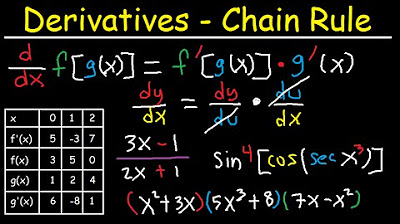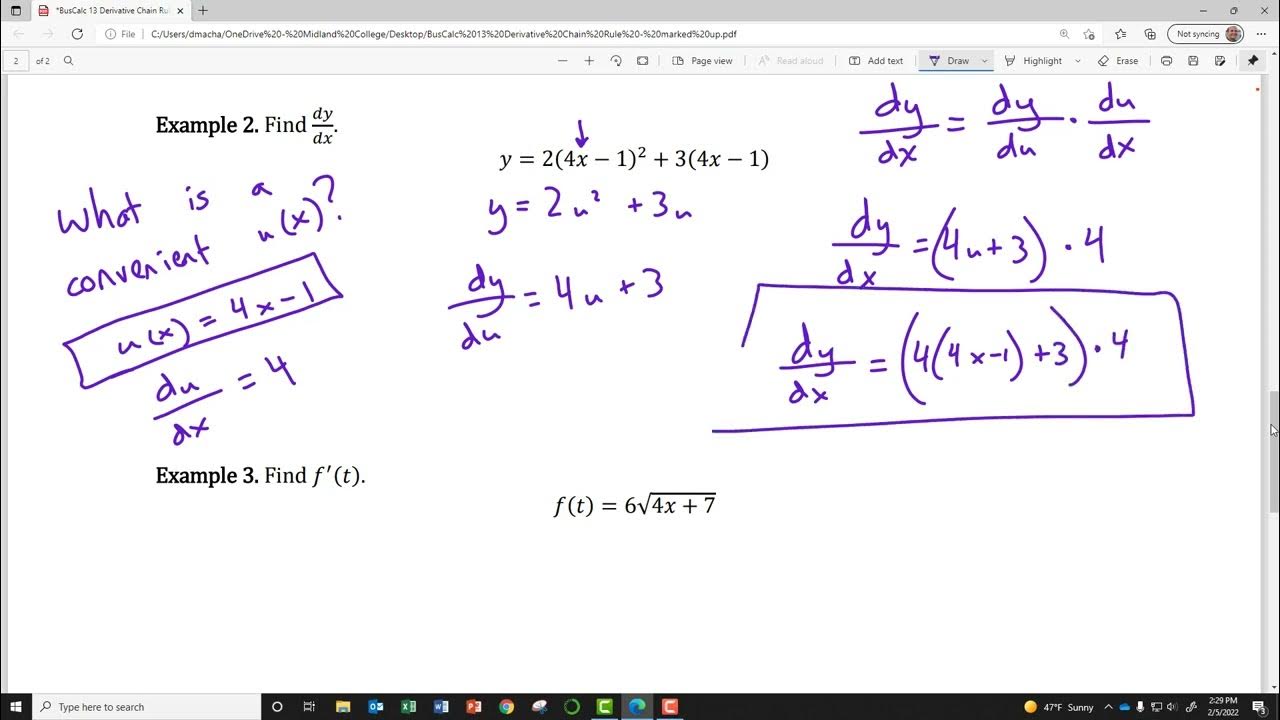Calculus - The product rule for derivatives
TLDRThis video tutorial delves into the product rule for derivatives, a fundamental concept for differentiating functions that are multiplied together. The instructor presents the formula, emphasizing the importance of correctly identifying and applying derivatives of each function. Tips for effective use, such as ensuring the rule's applicability and simplifying expressions, are provided. Examples illustrate the process, from finding individual derivatives to combining them using the rule, leading to simplified results. The video aims to clarify the product rule's application and enhance understanding of calculus.
Takeaways
- 📚 The video is a tutorial on the product rule for derivatives, which is used when two functions are multiplied together.
- 🔍 The formula for the product rule is to multiply the first function by the derivative of the second, and add it to the second function times the derivative of the first, keeping the order of multiplication flexible.
- 🛠️ It's important to apply the product rule only to functions that are being multiplied, not to those added, subtracted, or divided.
- 📝 Before applying the product rule, it's recommended to find the derivatives of each function separately to simplify the process.
- 🔄 The order of the functions in the product rule doesn't affect the outcome, as multiplication is commutative.
- 📐 The video provides an example where the derivative of \( H(x) = 2x^2 \cdot (3x^2 + 1) \) is calculated using the product rule, resulting in \( 12x^3 + 2x \).
- 📈 Another example demonstrates the derivative of \( \sqrt{x} \cdot (x^3 + 2x^2) \), emphasizing the need to distribute and simplify the expression after applying the product rule.
- 🌟 The video includes a third example with the function \( 4e^x \cdot \sqrt{x} \), showing how to find the derivatives of both parts and combine them using the product rule.
- 📘 The script mentions that the product rule is a handy tool for derivatives of multiplied functions, but careful placement of terms is crucial for accuracy.
- 👨🏫 The tutorial is designed to help viewers understand and apply the product rule effectively, with clear examples and step-by-step instructions.
- 🔗 For more educational content, viewers are directed to visit the website 'mysecretmathtutor.com'.
Q & A
What is the product rule for derivatives?
-The product rule for derivatives is a mathematical formula used to find the derivative of a product of two functions. It states that the derivative of a product of two functions, f(x) and g(x), is the derivative of the first function times the second function plus the first function times the derivative of the second function, mathematically represented as (f'(x) * g(x) + f(x) * g'(x)).
Why is it important to use the product rule only for functions that are being multiplied?
-The product rule is specifically designed for situations where two functions are being multiplied together. If the functions are added, subtracted, or divided, different rules such as the sum rule, difference rule, or quotient rule should be applied, or the chain rule might be necessary.
What are some tips for using the product rule effectively?
-Effective use of the product rule involves ensuring that you have two functions being multiplied, finding the derivatives of each function separately before applying the rule, and being mindful of the order in which the functions are multiplied, as the product rule is commutative in terms of function order.
Can you give an example of a function where the product rule is not applicable?
-An example where the product rule is not applicable would be a function that involves addition or subtraction of functions, such as f(x) + g(x) or f(x) - g(x). In these cases, the sum or difference rule should be used instead.
What is the derivative of the function H(x) = 2x^2 * (3x^2 + 1)?
-To find the derivative of H(x), you first find the derivatives of the individual functions: f(x) = 2x^2 has a derivative of 4x, and g(x) = 3x^2 + 1 has a derivative of 6x. Applying the product rule, H'(x) = 2x^2 * 6x + (3x^2 + 1) * 4x, which simplifies to 12x^3 + 4x.
How does the order of multiplication affect the product rule?
-The order of multiplication does not affect the product rule because it is commutative. Whether you write f(x) * g'(x) + g(x) * f'(x) or g(x) * f'(x) + f(x) * g'(x), the result will be the same.
What is the derivative of the function involving the square root of x multiplied by x cubed?
-The derivative of the function √x * x^3 involves finding the derivatives of √x (which is x^(-1/2)) and x^3 (which is 3x^2). Using the product rule, the derivative is √x * 3x^2 + x^3 * (-1/2)√x, which simplifies to (3x^(5/2) - x^(3/2))/2.
What is the derivative of the function 4e^x multiplied by √x?
-The derivative of 4e^x * √x requires finding the derivatives of e^x (which is e^x) and √x (which is 1/2√x). Applying the product rule, the derivative is 4e^x * (1/2√x) + √x * 4e^x, which simplifies to 2e^x/√x + 4e^x√x.
What does the video transcript suggest for simplifying the derivative expressions after applying the product rule?
-The video transcript suggests that after applying the product rule and obtaining the derivative expression, you should perform any necessary simplifications, such as combining like terms or canceling out common factors, to make the final expression as clean and understandable as possible.
Can the product rule be applied to functions that are not polynomials?
-Yes, the product rule can be applied to functions that are not polynomials, as long as the functions being multiplied are differentiable. The rule is a general derivative rule that applies to any two differentiable functions, not just polynomials.
Outlines
📚 Introduction to the Product Rule for Derivatives
The video script introduces the product rule for derivatives, a fundamental concept in calculus used when dealing with the derivative of two functions that are multiplied together. The presenter explains the formula for the product rule, emphasizing the importance of correctly identifying and applying the rule only to functions in multiplication. Tips are provided to ensure clarity and accuracy, such as finding the derivatives of each function separately before applying the rule. The script also highlights that the order of multiplication does not affect the outcome, as long as each function is multiplied by the derivative of the other.
🔍 Applying the Product Rule with Examples
This section of the script delves into applying the product rule through several examples. The presenter demonstrates how to find the derivative of composite functions by first identifying the two functions involved, calculating their individual derivatives, and then correctly applying the product rule formula. The examples include functions with polynomials and exponential terms, showing the process of distribution and simplification after applying the rule. The script emphasizes the importance of careful placement of terms and simplification to arrive at the correct derivative.
📝 Final Thoughts and Additional Resources
The final paragraph of the script wraps up the discussion on the product rule and encourages viewers to visit the website 'mysecretmathtutor.com' for more educational content. It serves as a call to action for those interested in further exploring calculus and derivative rules, providing a resource for additional learning and practice.
Mindmap
Keywords
💡Product Rule
💡Derivative
💡Functions
💡Power Rule
💡Simplifying
💡Chain Rule
💡Multiplication Order
💡Square Root
💡Exponential Function
💡Distribute
💡Composite Functions
Highlights
Introduction to the product rule for derivatives, a key concept for differentiating functions that are multiplied together.
Explanation of the product rule formula, detailing the steps to differentiate two functions when multiplied.
Emphasis on the importance of correctly identifying when to use the product rule, as opposed to other differentiation rules.
Tip to find the derivative of each function separately before applying the product rule for clarity and accuracy.
Clarification that the order of multiplication in the product rule does not affect the outcome.
Demonstration of the product rule with an example involving 2x squared and 3x squared plus 1.
Step-by-step guide to finding the derivative of the given example, showcasing the process of applying the product rule.
Illustration of simplifying the derivative after applying the product rule to obtain the final result.
Second example using the product rule with the square root of x and x cubed plus 2x squared, emphasizing the differentiation process.
Explanation of the derivative of the square root of x and its application in the product rule.
Final example involving the derivative of four times e to the x and the square root of x, showing the application of the product rule with exponential and radical functions.
Derivative of e to the x is e to the x, a unique property used in the product rule example.
Simplification of the derivative result after applying the product rule to the final example.
Conclusion summarizing the importance of the product rule and its correct application in calculus.
Invitation to visit the website for more educational content on calculus and other mathematical topics.
Transcripts
5.0 / 5 (0 votes)
Thanks for rating:





